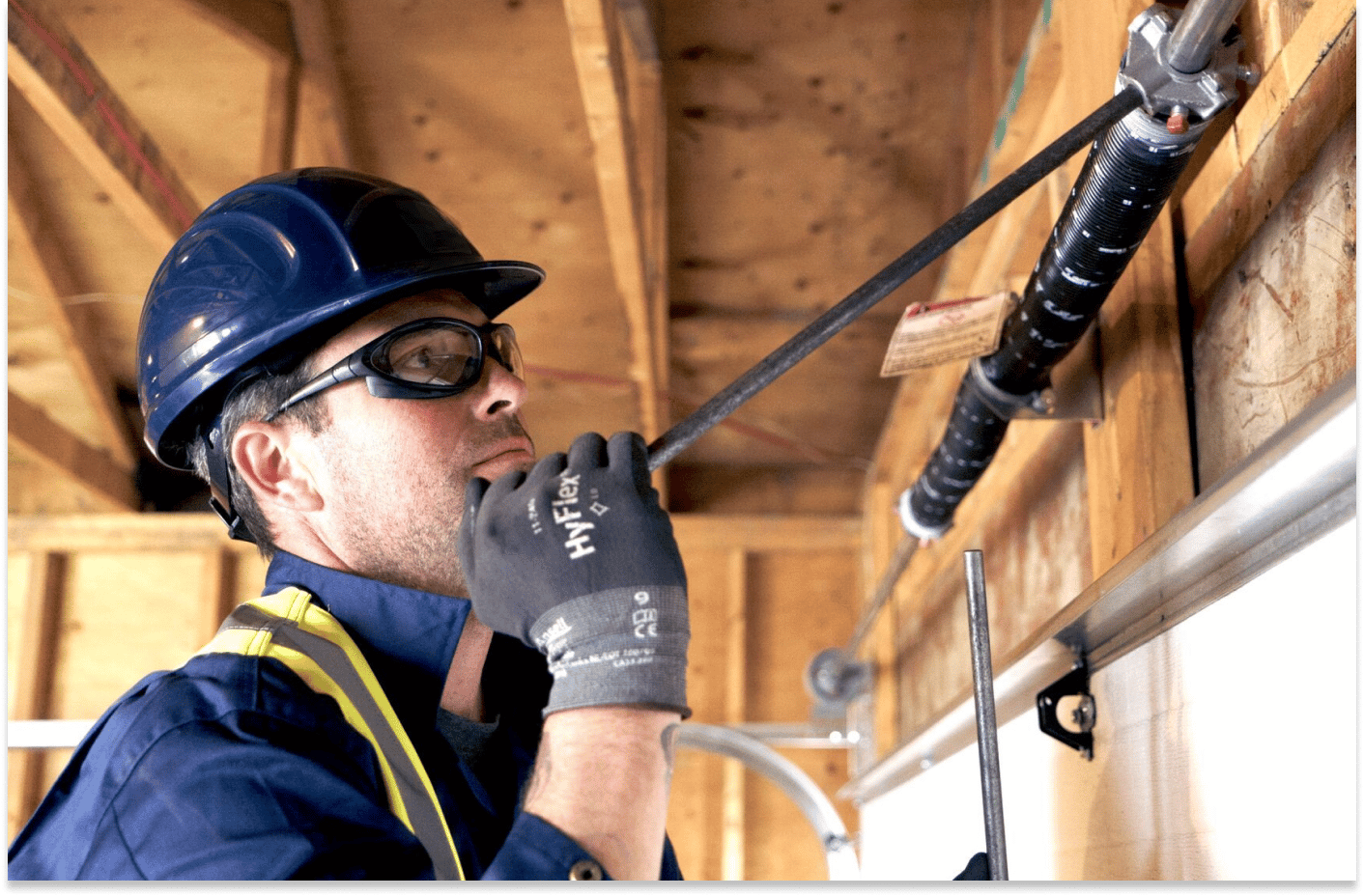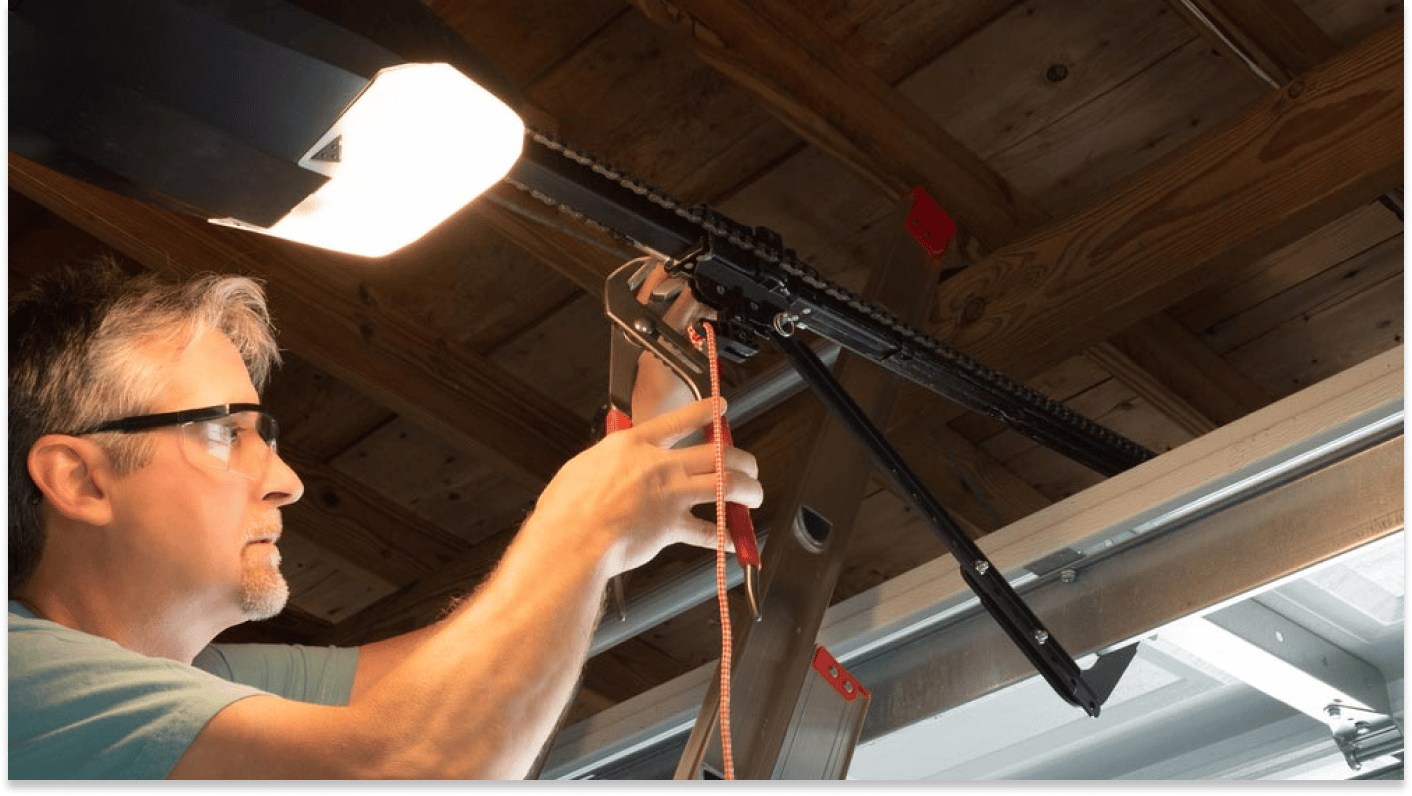Garage door springs are an essential component of all garage doors, and there are two main types: extension springs and torsion springs. Both types of springs serve the same purpose of counterbalancing the garage door’s weight, but they each do so differently.
Today, we will discuss the differences between an extension spring and a torsion spring, and we will give you some other super helpful information about garage doors and garage door parts. Let’s get started!
What Are Extension Springs?
Extension springs are attached to the upper tracks on either side of the door and typically run parallel to the door. When the door is closed, the springs are stretched out; when the door is opened, the springs contract and help to lift the door.
Extension springs are typically larger, and they pack a lot of torque when opening and closing your garage door.
What Are Torsion Springs?
Torsion springs are mounted above the garage door opening, and they twist and wind as the door is opened and closed. The torque that torsion springs create helps to lift and lower the heavy garage door.
Are Torsion and Extension Springs Necessary for My Garage Door?
The answer is yes! Both torsion and extension springs are important for garage doors. Without them, there is no lift. Your garage door will need to be lifted manually, or it can slam shut.
If you have an automatic garage door opener, your door will likely have one torsion spring. If your garage door is manual, it will most likely have two extension springs (one on each side of the door).
What Happens When Garage Door Springs Break?
If a spring snaps, the door will no longer be able to open or close. A broken spring, especially a broken extension spring, is a serious safety hazard and the door can come crashing down at any time. If you have a broken spring, your garage door requires service as soon as possible. We recommend that you call a professional garage door repair company right away.
Why Are Garage Door Springs Dangerous?
Garage door springs are dangerous because they are under a lot of tension. If one were to snap, it could cause serious injury or even death. That’s why we don’t recommend that homeowners attempt to replace their own garage door springs.
Which Are Better: Torsion Springs or Extension Springs?
Now that we know how each type of spring functions, you might be wondering which is better. The answer lies in the installation.
Garage Door Torsion Springs?
Torsion springs are considered to be safer than extension springs because they are generally smaller, wound less tightly, and sturdier on the shaft of the garage door. If a torsion spring breaks, it will not snap and fly across the garage, which could cause serious injury or property damage.
Garage Door Extension Springs?
Garage door extension springs, on the other hand, can seriously injure people or break items in your garage when they snap. An extension spring is also generally less expensive than a torsion spring, but it requires more parts and labor for installation.
Not all garage doors are created equal. If you’re not sure which garage door springs are right for your garage door, contact a professional today! They will be able to help you choose the best replacement springs and install them properly.
How Do I Know if My Garage Door Springs Aren’t Working?
If you notice that your garage door isn’t opening or closing as smoothly as it used to, there’s a good chance that a torsion or extension spring needs to be replaced. Other signs that your garage door springs may need to be replaced include:
- Your garage door is making strange noises.
- Your garage door opens or closes faster than usual.
- Your garage door is uneven when opening or closing.
- The springs are showing signs of wear, such as rust or breakage.
If you notice any of these signs, it’s time to call a professional garage door repair company.
Other Common Garage Door Issues
In addition to broken garage door springs, there are a few other common garage door issues that homeowners may experience. These include:
Misaligned Tracks
If your garage door tracks are misaligned, your door will not be able to open or close properly. This is usually caused by an issue with the rollers or brackets. Sometimes, debris becomes lodged in the tracks, causing one side to slip or stick while the other tries to function properly.
To fix this issue, you can first try wiping down the tracks and ridding them of any outdoor debris or dirt. If that doesn’t work, call in a professional to assess the problem. The tracks may be bent, or there may be issues with other garage door parts.
Broken Cables
Your garage door cables help to lift the heavy door. If the extension spring cables break, you will need to replace them as soon as possible.
This is not a job we recommend for the layperson or homeowner. You want someone with experience to fix broken cables because some disassembly is required, and you don’t want to be caught under a heavy garage door when something goes wrong.
Damaged Panels
If one of your garage door panels is damaged, it will need to be replaced in order to keep your door functioning properly. Damaged panels are typically caused by impact from a car or debris during a storm.
You can try to pop out the dent similarly to how you might try to pop a dent out of the body of your car, but if the damage is severe, you may want to have it replaced by a professional. Damaged panels are an eyesore to the rest of the neighborhood, so don’t leave them dented for too long.
Worn-Out Hardware
Over time, the hardware on your garage door will start to wear out. This includes the hinges, rollers, and screws. When this happens, you will need to replace the worn-out garage door parts.
If your hardware isn’t rusted, just squeaky, you can go at it with some store-bought lubricant. Sometimes, especially in climates that experience rain and snow, your hinges just need a little grease to get back to normal.
When Should I Replace My Garage Door Springs?
It’s generally recommended that you replace both torsion and extension springs every seven to nine years. However, if you use your garage door regularly, you may need to replace them more often.
If one of your springs breaks, it’s important to replace both springs, even if the other one doesn’t seem like it needs to be replaced. This is because when only one spring breaks, the other one is sure to break soon after.
Compare this to when one of your car tires is worse than the others. Usually, you replace all of your car tires at the same time so your car stays aligned. It’s the same with garage door springs. They should be even so your whole garage door operates smoothly.
Can I Replace Garage Door Springs by Myself?
Unless you are a trained professional, we do not recommend that you replace your garage door springs by yourself. Replacing your garage door springs can be a dangerous job, so it’s best to leave it to the professionals. Contact a local garage door repair team like LexD today to schedule a free consultation!
Your Safety Is Important
The obvious reason for this involves your safety and the safety of your loved ones. Replacing broken springs is not like replacing the batteries in your garage door opener, or programming a wall-mounted garage door opener. Springs are dangerous, and you can suffer serious bodily harm if you mishandle them.
Don’t Make the Problem Worse
The other major reason we recommend hiring a specialist is that they will do the job right, and not jeopardize the other functions of your garage door. Each part affects the others in a garage door system, so if you mess up in one place, it will decline the overall function and performance of your garage door.
How To Size Torsion Springs for Your Garage Door
The size of the torsion springs on your garage door has a lot to do with the weight of your door. Heavier doors will require larger springs. If you have a standard single-car garage, you may need only a smaller spring. If you have a double-car, heavier garage door, you will need larger springs.
How To Size An Extension Spring for Your Garage Door
Garage door extension springs are sized according to the length and width of your garage door.
To get an accurate measurement, you will need to measure the height, width, and thickness of your garage door. Once you have these measurements, you can refer to a spring size chart to find the right size for your door.
Is It Worth It to Size My Own Garage Door Springs?
If you’re trying to save money, you can look up YouTube videos on how to size springs for your garage door, purchase the correct springs, and give them to your installer to use. However, it doesn’t tend to be worth the time spent.
When Should I Call a Professional?
If you’re not sure how to measure your garage door or you can’t find the right size springs in a spring size chart, it’s best to call a professional. A professional garage door installer will be able to quickly and easily size the springs for your door and have them installed in no time. They’ll take your old spring out and dispose of it, and give you shiny brand new springs that will last for years to come.
How Much Does It Cost To Replace Garage Door Springs?
Replacing your garage door springs typically costs a couple to several hundred dollars. The exact price will depend on the size and weight of your garage door and the type of springs or garage door parts you need.
If you’re looking for a more affordable option, you can try to find a lightly used garage door extension spring or torsion spring. However, we don’t recommend this because used garage door springs may not be the right size, or they may be damaged. It’s best to just buy new garage door springs.
Hiring a professional to replace your garage door springs is the best way to ensure that the job is done right and that you and your family remain safe and get the most out of your garage door.
How To Find Reliable Local Garage Door Repair Services
When your garage door breaks, it’s important to find a reliable garage door repair company to fix it. Here are a few tips on how to find local garage door repair services:
1. Get referrals from friends and family.
2. Read online reviews.
3. Look for a company with experience.
4. Make sure the company is licensed and insured.
5. Ask for a free consultation.
If you follow these tips, you should be able to find a reputable garage door repair company in your area. Don’t underestimate referrals that you get from family and friends, and verify that the company has experience with garage door repairs. Take online reviews with a grain of salt, and look at several companies before committing to one.
Fix Your Extension Spring or Torsion Spring Today!
Garage doors have many moving parts. If your garage door isn’t working properly, there’s a good chance that your springs need to be replaced. Hopefully, you now know how to tell if your torsion springs or garage door extension springs need servicing.
Replacing garage door springs and other garage door parts is a job best left to the professionals. Contact a local garage door repair company like LexD today to schedule a free consultation and get your garage door spring issues resolved!






